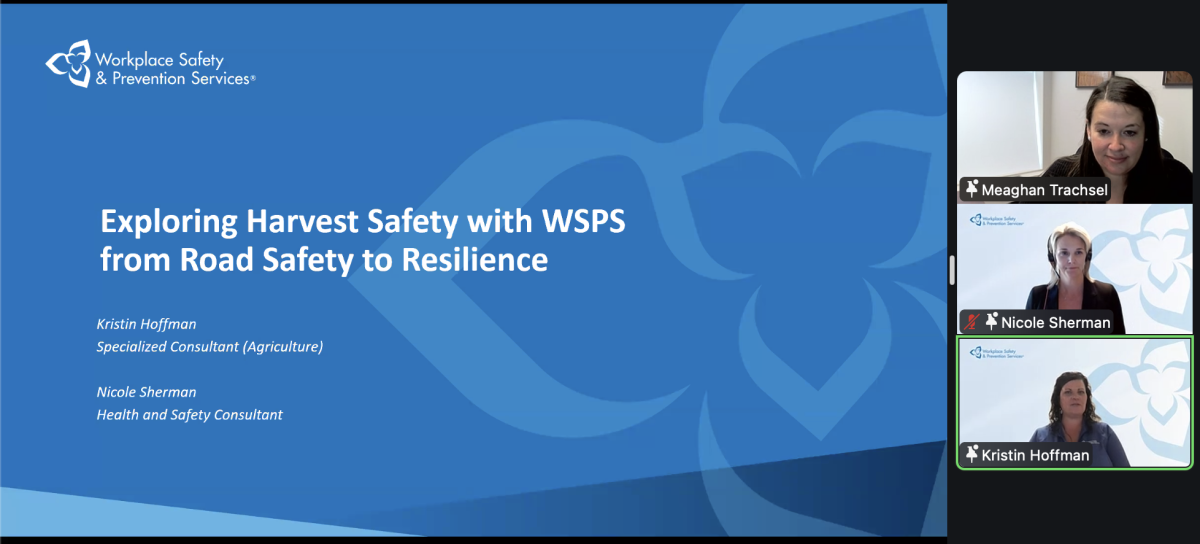Agreement among Canada’s sitting agriculture ministers on the content of their next five-year policy framework has farm groups concerned about how to manage future risk, if or when the commodity boom becomes a bubble.
Agriculture Minister Gerry Ritz and his counterparts from all provinces and territories — except Quebec, now in between ag ministers after its Sept. 4 general election — put the focus of the new framework on “innovation, market development and long-term growth” coming out of their meeting this week in Whitehorse.
Out of today’s agreement, provinces and territories are expected to complete bilateral agreements so programs are in place when the current Growing Forward framework expires at the end of March 2013.
Read Also

Exploring Harvest Safety
Kristin Hoffman of WSPS explains measures for increased farm safety around harvest season
The new five-year agreement, “Growing Forward 2” (GF2), earmarks over $3 billion for “innovation, competitiveness and market development, including a 50 per cent increase in governments’ cost-shared initiatives.”
The new agreement also calls for “greater flexibility for provinces and territories to tailor programs to local needs” and more opportunity for those governments to invest in environmental initiatives and on-farm water infrastructure.
However, the ministers’ statement on funding for business risk management (BRM), the biggest portion of the last two ag policy funding frameworks, goes only so far as to say their governments “will continue to deliver a complete and effective suite of (BRM) programs to ensure farmers are protected against severe market volatility and disasters.”
Under GF2. they added, the BRM suite’s AgriStability income stabilization program will offer “improved negative margin coverage” and lower program fees.
The BRM suite, they said will also “substantially increas(e) farmers’ ability to contribute greater funds into their AgriInvest accounts to better manage risk.”
The federal and provincial governments also pledged to work with the ag sector to “encourage the development of private sector risk management tools.”
They also promised to continue to monitor and review BRM programming over the term of the framework (2013 to 2018), specifically pledging a “mid-term review” of the BRM suite.
BRM program reform, they said, is “in line with government and industry agreement that programs should not mask market signals and should create space for the development of private risk management tools.”
“On the other hand”
“I think most farmers will be split on these changes,” Stephen Vandervalk, president of Grain Growers of Canada, said in a separate release Friday.
“On one hand we have aggressively lobbied for more investment into research and innovation and so are pleased to see more funding there, but on the other hand there are substantial cuts to some key risk management programs.”
GF2, as agreed upon this week, calls for lowering AgriStability margin coverage from 85 to 70 per cent. Producers’ reference margins under AgriStability will be limited to the lower of their historical reference margin or allowable expenses reported in previous years.
Also, a producer’s AgriStability payment will not be based on a tiered support system but on the same level of government support — 70 per cent — regardless of the extent of margin loss, including negative margins.
Governments’ annual matching dollars on a farmer’s AgriInvest contributions will be lowered to one per cent, down from 1.5 per cent, of the farmer’s allowable net sales (ANS).
However, a farmer will be able to contribute up to 100 per cent of his or her ANS per year to AgriInvest, and up to 400 per cent of ANS in total, to “better use AgriInvest as a risk management tool,” the governments said.
“Farmers will be disappointed with the cuts to AgriInvest as we understood the program,” Allan Ling, president of the Atlantic Grains Council, said in the GGC’s release.
“The big challenge with (previous ag income stabilization plans) CAIS and AgriStability was how hard they were to understand and so I’m hoping the changes to AgriStability, like on negative margins for example, will help it to be more predictable so that as farmers we know what our coverage is every year.”
“Although we are pleased with the increased funding to strategic initiatives in the new agreement, we are very disappointed that this investment comes at the expense of the risk management programs,” SaskCanola chairman Brett Halstead said in a separate release.
“The BRM cuts will result in decreased support to farmers during years of lower commodity prices when income support is critical.”
The Canadian Cattlemen’s Association said the agreed-upon changes to BRM programs “are different from what the CCA lobbied for, but we appreciate the commitment to continue examining expansion of insurance for livestock producers.”
New committee
GGC executive director Richard Phillips added, however, that the group is pleased to see “additional money” for research.
“Having varieties of grain with better yields and more resistance to insects, diseases and drought will help stabilize our farm incomes and may help reduce the need to draw on support programs in future years.”
To that end, Ritz on Friday also announced the creation of an “Agri-Innovators’ Committee,” a new national advisory body to provide “expert advice” on ag research and development. Its members include:
- co-chair Travis Toews, past-president of the Canadian Cattlemen’s Association;
- co-chair Suzanne Vinet, federal deputy minister of agriculture (starting Monday);
- Lloyd Affleck, board chairman of Canterra Seeds Holdings;
- Shelley Doan, president of dairy cattle export firm Trans World Cattle Co.;
- David Fuller, former chairman of Chicken Farmers of Canada;
- Don Kenny, former chairman and current director of Grain Farmers of Ontario;
- Janie Levesque, a livestock nutrition researcher with Genetiporc in Quebec;
- Shaun Moran, Grains, president of Manitoba special crops export firm Moran Commodities;
- Jim Thorne, CEO of custom frozen dinner processor Marsan Foods;
- Bill Vanderkooi, president of B.C.-based Bakerview EcoDairy and CEO of Nutriva Group;
- David Vincent, a director with the Federation des producteurs de porcs du Quebec; and
- Rick White, general manager of the Canadian Canola Growers Association.
The ag ministers’ next annual meeting is to be held in Halifax in July 2013.
Related stories:
CFA calls for continued government support, July 26, 2012
Ottawa seeks heavier trigger pull on AgriStability: report, July 10, 2012
Agriculture department grazed in federal cost-cutting, March 30, 2012
















